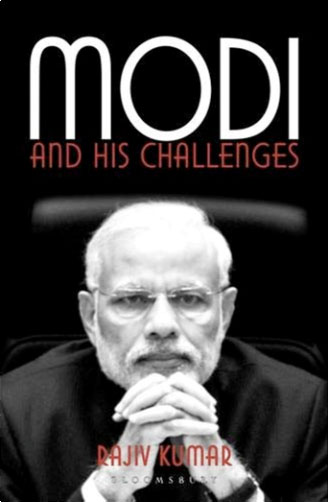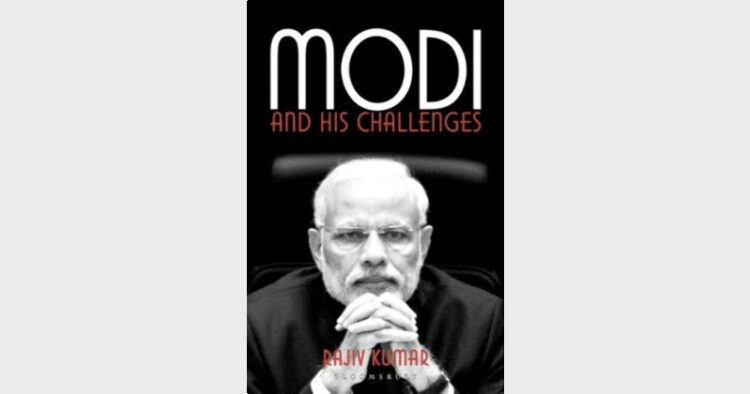| Modi and His Challenges; Rajiv Kumar; Bloomsbury Publishing India Pvt Ltd ; Rs INR 599 |
 For those who want to get a deep insight into the persona of Narendra Modi and its possible correlation with his policy initiatives, ‘Modi and his Challenges’ deserves a place on their essential reading list
For those who want to get a deep insight into the persona of Narendra Modi and its possible correlation with his policy initiatives, ‘Modi and his Challenges’ deserves a place on their essential reading list
Priyang Pandey
Prime Minister Narendra Modi has been one of the most influential personalities of our times. His charismatic persona and his dynamic leadership have polarised the world in which some idolise him, while others question his policies and style of functioning.
In an attempt to break the myths around who Narendra Modi really is, the author ventured into taking us through a journey of the leader’s life, his aspirations, his political trajectory, his remarkable stint in Gujarat and his performance over the last two years in Delhi.
The author identifies the many formidable challenges Prime Minister Modi faces as the leader of the world’s largest democracy which is in the midst of a complex transition and recommends measures that Modi must deliver on his promises, thereby enabling India to realise its true potential. The book gives you a reason to understand a man who has managed to transfix attention of millions of Indians for nearly two years and defied being stereotyped.
The author has very well arranged the contents, so as to give a glimpse of Modi’s career in a chronological order, starting with a chapter on his ideals, ideology and influences and ends with Modi of Lutyens with a chapter on Modi as Gujarat’s Chief Minister in between. The author has very lucidly narrated every little detail of his journey as a politico, about his days of initial association with Rashtriya Swayamsevak Sangh. This chapter also describes about the person who introduced him to RSS and vice-versa, ‘Vaqeel Sahab’.
New ArrivalsDara Shukuh: Captive Visionary of His Times; Rakesh Gupta; Kalpaz Publications; Pp 236; Rs 790 The book deals with the times, life and works of Dara Shukuh as a Sufi scholar and a military man subsumed under Akhlaq working for social cohesion within Akbar’s dominant state ideology. The book contextualises him in the times as part of the opposition between orthodoxy and heterodoxy around the grid of equality of religious and not priority of a religion. Suicide?: There is always a Tomorrow; The book has a simple message to convey that is to spare no effort to achieve the professional goal one sets for self, but not to kill oneself if it did not happen due to some reason. The book is based on personal experience as well as those of colleagues and juniors. It deals with the subject comprehensively by tracing background to such high-pressure situation for a student carrying burden of expectations of his/her family. The Path of Yoga; Osho; Diamond Books; Pp 256; Rs 250 This book introduces us to Patanjali, the founder of ancient Yoga in India. It takes us step by step into a deeper understanding of the essence and origins of Yoga. Osho introduces and unlocks Patanjali”s ancient sutras, revealing how contemporary this ancient message truly is. Surprisingly, the mind, even more than the body is the focus of Patanjali”s teaching. He says: “Yoga is the cessation of mind.” The Heart of Yoga; Osho; Diamond Books; Pp 288; Osho describes Patanjali as a mathematician of the ultimate poetry; a mystic with a scientific mind, who analyzes and dissects as if in a lab, but his lab is one of the inner being. Patanjali has searched deeply into human energy and devised many techniques; he has found that in order to meditate, the body, mind, and being need to be healthy. |
This book is an excellent expert analysis of Prime Minister Narendra Modi’s new economic policy, written with what might be called “critical sympathy’.
This second rationale of this book is to spell out Modi’s ideological premises. A naive understanding of Modi as a RSS pracharak or as a person who has been driven exclusively by personal ambition will be highly misleading. This poor understanding will prevent us from fully grasping his current economic policy stance and developmental agenda. Even more important perhaps, it won’t permit us to look ahead to see where India might be heading towards under his rule. Modi has amply demonstrated that he combines the elements of Hindutva, development objectives, and vigorous nationalism. Therefore, the next chapter, admittedly with some audacity, attempts to understand the principal drivers of Modi’s behaviour, as he negotiates the complicated terrain of India’s political economy. In doing so, we come close to sketching the contours of a new idea of India which has to be viewed from a non-Nehruvian and certainly non-Western perspective. This is necessary because from all accounts, Modi has a markedly different worldview than all previous occupants of the prime minister’s office of the first floor in South Block on the Raisina Hill.
The last chapter enhances the readers’ understanding of Modi, thereby allowing them to better manage their expectations in the coming years from Modi’s India, which will hopefully be an India free of ‘Congressism’ that has so far prevented the country from exploiting its amazing potential.
“We are much better off dreaming and taking risks, and trying to realize a billion aspirations; at best we risk falling flat on our faces. Far more egregious, and most dangerous to our country, is going about ‘business as usual’, leaving a billion voices unheard and a billion frustrations unresolved”. The author has also identified several daunting challenges that Modi faces in taking India towards its desired and feasible goal of becoming a prosperous economy by 2047, which will mark the centenary of its independence from British rule. The principal argument is that in some areas – like macroeconomic management, education, agriculture, manufacturing and exports, and infrastructure– Modi’s current business-as-usual approach with reforms at the margins may not deliver an anticipated result. In these sectors, an innovative approach including a
programme of structural reforms and a clean break from the past are required.
The most critical aspect which he deals with is the possible shift in India’s economic policies. The author believes that what Modi can implement would be to change the policy goal from GDP growth to maximising the rate of growth in employment generation. This is
critically needed if India is to meet its extraordinary goal of generating as many as one million jobs per month, which are needed to absorb the net accretion to its workforce. Employment maximisation will also imply active promotion of labour intensive manufactured exports.
The author is essentially an
economist and has deep insights into economic policies. Till now he has written a lot of books and articles on economy and international trade. He has been associated with institutions like FICCI, CII and ICRIER and is now with Centre for Policy Research. He was a member of the Government of India’s National Security Advisory Board between 2006 and 2008. Despite this background as a specialist in the economic field, the kind of political understanding and acumen he has shown in analysing both
personality and policies of Prime Minister Modi is phenomenal. For those who want to get a deep insight into the persona of Narendra Modi and its possible correlation with his policy initiatives, ‘Modi and his Challenges’ deserves a place on their essential reading list.














Comments